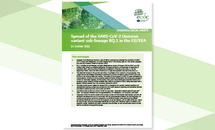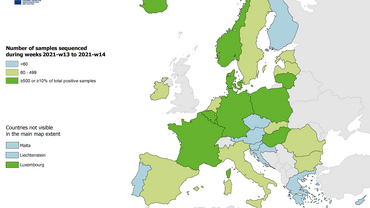Spread of the SARS-CoV-2 Omicron variant sub-lineage BQ.1 in the EU/EEA
European Union/European Economic Area (EU/EEA) countries have detected the circulation of SARS-CoV-2 variant sub-lineages BQ.1 in levels ranging from 0−19% during week 40. This variant originates from the BA.5 Omicron Variant of Concern (VOC).
Executive Summary
- BQ.1, including its sub-lineages, has been designated as Variant of Interest (VOI) by ECDC as of 20 October 2022. Based on modelling estimates, it is expected that by mid-November to beginning of December 2022, more than 50% of SARS-CoV-2 infections will be due to BQ.1/BQ.1.1. By the beginning of 2023, more than 80% of SARS-CoV-2 cases are expected to be due to BQ.1/BQ.1.1.
- The observed increase in the growth rate of BQ.1 is probably driven mainly by immune escape. This variant and its sub-lineages will probably contribute to a further increase in cases of COVID-19 in the EU/EEA in the coming weeks and months. The extent of the increase in COVID-19 cases will depend on various factors, including immune protection against infection influenced by the timing and coverage of COVID-19 vaccination regimes, and the extent, timing and variant landscape of previous SARS-CoV-2 pandemic waves. Based on limited available data, there is no evidence of BQ.1 being associated with a greater infection severity than the circulating variants BA.4/BA.5.
- Countries should remain vigilant for signals of BQ.1 emergence and spread; maintain sensitive and representative testing and genomic surveillance with timely sequence reporting and strengthen sentinel surveillance systems (primary care ILI/ARI and SARI).
- Countries should continue to monitor COVID-19 case rates - especially in people aged 65 years and older - and severity indicators such as hospitalisations, ICU admissions, ICU occupancy and death.
- Improving COVID-19 vaccine uptake of the primary course and first booster dose remains a priority for all eligible individuals that are not up-to-date with the recommended schedule. For the time being, for current autumn/winter vaccination campaigns, an additional booster dose should also be offered, prioritising individuals who are at risk of progression to severe disease, such as older adults (e.g. above 60 years of age), immunocompromised individuals and those with underlying medical conditions, and pregnant women. Residents and staff in long-term care facilities, as well as healthcare workers should also be considered among priority groups.
Download

Spread of the SARS-CoV-2 Omicron variant sub-lineage BQ.1 in the EU/EEA - EN - [PDF-682.06 KB]







